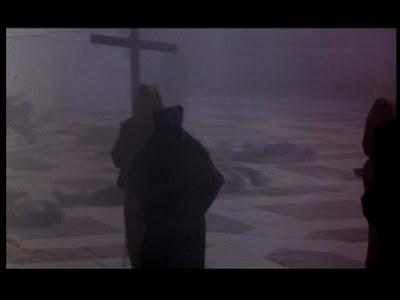Nosferatu a Venezia (1988) is a rare film which can successfully sustain claims of both total incompetence and artistic genius. Both claims have strong merit.
Professor Catalano (Christopher Plummer), a renowned expert on vampirism, is summoned to Venice, Italy at the request of Princess Helietta Canins (Barbara De Rossi). The princess resides in her familial manor with her aged mother, younger sister, and spiritual advisor, Don Alvise (Donald Pleasence). She is convinced that an evil curse has overtaken the manor and has infected the entire family. Below the manor and below the canals of Venice, a tomb is located, bound completely in chains. The princess believes this tomb houses the source of the evil and wants Professor Catalano to help her open the tomb and end the curse. He says no.
The ancient evil residing in the tomb might actually be the legendary vampire, Nosferatu (Klaus Kinski), to whom Professor Catalano has devoted his life’s study. Opening the tomb, the professor argues, would be unleashing too great an evil. He presents evidence supporting his claim:
Two hundred years prior to the present day, Nosferatu’s last known appearance occurred in Venice while a plague was overtaking the populace. Specifically, Nosferatu was last seen in the princess’s palatial manor and had given one of her ancestors the vampire’s kiss. Nosferatu disappeared thereafter, never having been seen again.
The princess is adamant. The family and the house are cursed, and the curse must be lifted. She schedules a séance at her home where a medium successfully summons Nosferatu from his slumber. Interestingly, it appears that during the séance, the ancestor of the princess channeled her spirit through the body of the princess. Nosferatu, in effect, must have been called back to the world of the living by his last victim who is also clearly in love with the creature. Shit is about to go from bad to worse.
Among real cult-film aficionados, Nosferatu a Venezia is a curiosity, known for its troubled production history. The IMdB, as trivia, lists these facts, which are mostly corroborated by Luigi Cozzi, an assistant to the production, here (especially pages five and six). Given the production problems, it is unsurprising then that Nosferatu a Venezia appears disjointed and poorly-structured. The film is totally unengaging on an emotional level and extremely difficult to follow, despite a very simple narrative. Producer, and subsequent director, Augusto Caminito failed to make a film equal in praise to its predecessor, Werner Herzog’s masterful Nosferatu: Phantom der Nacht (1979). Instead, at its most superficial level, Nosferatu a Venezia is a travelogue of the beautiful city of Venice and of Klaus Kinski traversing its streets, alleys, and canals. In between the sequences of the city and of Kinski, some story unfolds. This is not say that there are not brilliant sequences which are very memorable.
After Nosferatu has entered the manor a couple of times, one time committing murder and the other assaulting the princess, the professor and company realize that Nosferatu may be coming back again. In a daylight sequence in an enclosed garden behind the manor, the professor feels a climate change and knows that Nosferatu is coming. With a shimmer in his eye, the professor realizes that his entire life study is about to come to its fruition: an ultimate confrontation with Nosferatu. (Plummer deserves a lot of praise for his performance, as it is quite good.) Kinski appears in dramatic fashion. Nosferatu rebuffs two powerful shotgun blasts from the local doctor (and also, incidentally, the princess’s would-be paramour). Plummer’s professor grabs his cross and begins a litany, one it appears that he has been preparing for a while. Kinski, in an essential Kinski moment, seems slightly perturbed at the sight of the professor. (One of the best emotions that Kinski could faithfully and inimitably produce is that of contempt. He is in top form, here.) De Rossi appears at the stairs and beckons for Nosferatu. Kinski now sees Plummer’s character as inconsequential and with an unforeseen incendiary ability, violently heats the cross in Plummer’s hands. The professor drops to the ground with his wounded hands (and even more so, wounded pride), and Nosferatu nonchalantly steps over him to take the princess’s hand. An amazing sequence.
The subsequent sequence rivals its predecessor, where Plummer, thoroughly defeated, packs his bags to leave the manor. Plummer gives this wonderful speech about failure while Don Alvise follows behind him, shaming him by yelling at the top of his lungs. (Pleasance gives a bizarre, emotional performance. His character has almost no narrative weight in the final film. This anomaly quality of his character just heightens the disjointed nature of the film.) Plummer crosses a pedestrian bridge across one of the canals and a gulf of fog overtakes him. When the fog clears, his character is gone, while his suitcase floats in the canal below. Unbelievable.
Anyone who has had the pleasure of reading Klaus Kinski’s autobiography, Kinski Uncut, is well aware that Kinski quite enjoyed fucking or at the minimum, quite enjoyed writing about fucking in descriptive detail. Unfortunately, I could decipher little in its text about Nosferatu a Venezia, but the final act of the film seems as if it could have come from pages from his autobiography. Describing the final act, here, would be a disservice, but I hope that I have hinted towards its content sufficiently. The final act is ridiculous, over-the-top, and much like the final film, totally incompetent or artistically brilliant.
Nosferatu a Venezia has a DVD release from Germany, available here. It is well worth seeing, if you are a serious fan of the antiquities and curios of European cult cinema.




1 comment:
I thought this was poetic and enjoyable. Well worth a watch
Post a Comment